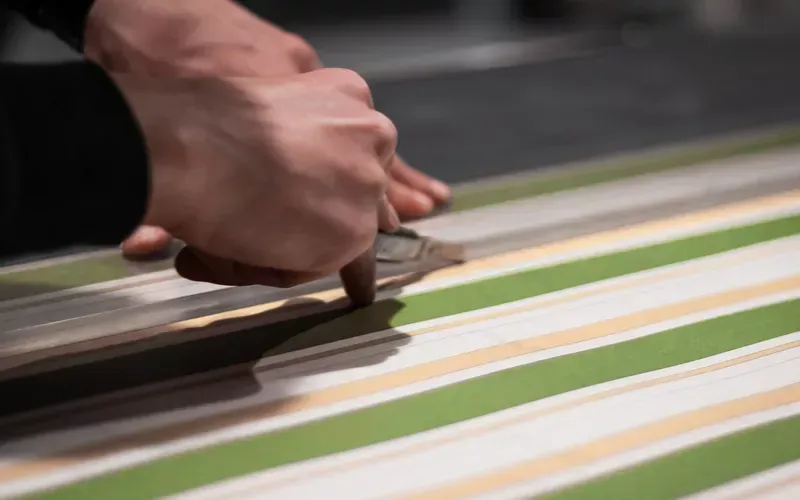
Can You Apply Vinyl Wrap to MDF and Get Professional Results?
October 28, 2025Why MDF Needs Special Attention Before Wrapping
MDF, or medium-density fibreboard, is widely used in furniture manufacturing due to its affordability and smooth finish. Despite its clean appearance, the material has specific characteristics that affect vinyl adhesion.
MDF is porous, especially when unsealed. If a wrap is applied directly to raw MDF, it may not bond well. This often leads to lifting, bubbling, or poor long-term durability.
The edges are particularly sensitive and tend to absorb more adhesive than flat surfaces. Preparing the surface correctly is essential for achieving a stable and long-lasting finish.
Check out our vinyl wraps collection to find the perfect wrap for your interior.
Surface Preparation: The Key to a Professional Result
Before wrapping any MDF surface, preparation is critical. This includes cleaning, sealing, and smoothing the material to ensure maximum adhesion.
Tools and Materials Required
Fine-grit sandpaper
Cleaning cloths
Isopropyl alcohol or a residue-free surface cleaner
MDF primer or wood sealer
High-quality interior vinyl wrap
Squeegee or felt-edged applicator
Heat gun for corners and curves
Utility knife for trimming
Preparation Steps
Inspect the surface
Identify any imperfections, chips, or rough edges that need repair. Fill in any dents or damage with appropriate filler and allow it to dry completely.Sand the surface
Light sanding removes surface irregularities and creates a better bonding surface for the adhesive. Pay special attention to edges, which often require extra smoothing.Clean thoroughly
Use a clean cloth and isopropyl alcohol to remove dust, oils, and any other contaminants. The surface must be immaculate before applying primer.Seal the MDF
Apply a primer or sealer, especially on exposed or raw MDF. This reduces absorption and prevents the adhesive from soaking into the board. Let the primer dry thoroughly before continuing.Final inspection
Ensure the surface is dry, smooth, and free of residue. Once everything is ready, you can begin the wrapping process.
Choosing the Right Vinyl for MDF Surfaces
Not all vinyl films are suitable for furniture wrapping. For MDF, especially, it is essential to use a film designed for interior applications.
Professional-grade vinyl offers several advantages:
Thicker film provides better coverage of minor surface defects
Stronger adhesive improves long-term hold, especially on sealed edges
Available in a variety of finishes such as matte, gloss, wood grain, or stone
Heat-resistant properties allow for easier wrapping around curves and corners
These types of films are more durable and deliver a more authentic finish compared to standard decorative vinyls.
Benefits of Wrapping MDF Instead of Replacing Furniture
Wrapping MDF furniture is an effective way to give old or worn pieces a new appearance without the cost of replacement. In many cases, the underlying structure is still solid, and only the finish requires updating.
If you want to learn about our custom and personal wraps, you can read more in this short but useful (especially for the beginners) article
Common Benefits
Cost savings
Wrapping is significantly more affordable than purchasing or building new furniture.Less waste
Reusing existing pieces reduces environmental impact and avoids unnecessary disposal.Design flexibility
Vinyl wraps are available in a wide variety of textures and colours. This allows for easy updates based on seasonal trends or personal preference.Minimal disruption
The wrapping process can often be completed in place, avoiding the mess and downtime associated with painting or replacement.Durable results
When installed correctly, professional vinyl can resist scratches, moisture, and everyday wear.
When Wrapping May Not Be Suitable
There are situations where wrapping MDF may not be the best solution. If the board is warped, heavily damaged, or exposed to moisture over time, it may not provide a stable base for vinyl application.
Consider other options if:
The MDF is delaminating or structurally weak
The surface has significant water damage or mold
The preparation process would require excessive repair work
In these cases, replacing the panel or furniture may offer a more effective and lasting result.
Conclusion
Applying vinyl wrap to MDF is a practical and cost-effective way to update interior furniture and surfaces. When the MDF is appropriately prepared and sealed, and the right type of film is used, the result can be clean, professional, and long-lasting.
This method is handy for refreshing kitchen cabinets, wardrobes, shelving, or decorative panels without replacement.
For best results, it is recommended to use vinyl films that are specifically made for furniture wrapping and interior use.
Whether you're working on a DIY home project or considering options for a client, wrapping MDF is a proven technique for giving furniture a second life with minimal disruption and high visual impact.